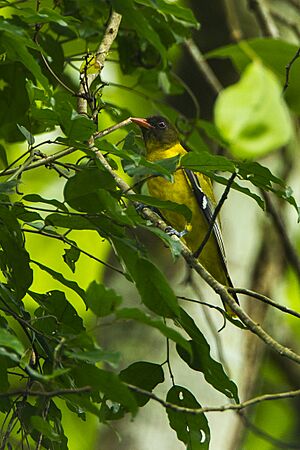Western oriole facts for kids
Quick facts for kids Western oriole |
|
|---|---|
 |
|
| Conservation status | |
| Scientific classification | |
| Genus: |
Oriolus
|
| Species: |
brachyrynchus
|
| Synonyms | |
|
|
The western oriole (Oriolus brachyrynchus), also known as the western black-headed oriole, is a type of bird that lives in Africa. It belongs to the Oriolidae family. Adult western orioles have yellow-olive feathers on their upper body and bright yellow feathers underneath. This bird is listed as a species of least concern by the IUCN Red List, meaning it is not currently in danger of disappearing.
About Its Name and Family
The western oriole was first described in 1837 by an English bird expert named William Swainson. Sometimes, people call this bird the black-headed oriole or the greenish-backed oriole. However, there is another bird called the black-headed oriole (Oriolus larvatus), so it's good to be specific!
Scientists recognize two main types, or subspecies, of the western oriole:
- The West African black-headed oriole (O. b. brachyrynchus) – This type was named by Swainson in 1837. It is found from Guinea-Bissau all the way to Togo and Benin.
- The Cameroon black-headed oriole (O. b. laetior) – This type was named by Sharpe in 1897. It lives from Nigeria to western Kenya, and also in parts of the Democratic Republic of Congo and northern Angola.
Genetic studies show that the western oriole and the green-headed oriole (Oriolus chlorocephalus) are very closely related. They are considered sister species, meaning they share a recent common ancestor.
What It Looks Like
The western oriole is about 21 centimetres (8.3 in) long, which is roughly the length of a standard ruler. It weighs between 42 to 57 g (1.5 to 2.0 oz), which is about the same as a few chocolate bars.
Adult birds have yellow-olive feathers on their upperparts. Their head and upper chest are black, and they have a small white patch on the edges of their wings. Their beak is a brownish-pink color. The feathers on their underparts are bright yellow. Their tail feathers are black with wide yellow tips.
Young western orioles, called juveniles, have olive-colored upperparts. Their head is also olive, and their throat has yellow streaks. They have a dark-colored beak and black streaks on their chest.
This bird makes many different musical sounds. Some of its calls sound like uoo-uoo, uoo-dleeo, tioolioo, whee-whooliu, whoolioo, and too-too-tuloo. These notes are usually separate and lower in pitch than the calls of the black-winged oriole (Oriolus nigripennis). It can also make a harsh whit-cheeew-cheeew sound.
Where It Lives
The western oriole is found in western and central Africa. It is native to the rainforests of countries like Sierra Leone, Guinea, Liberia, Ivory Coast, Benin, and Ghana.
These birds live either alone or in pairs. They prefer to stay high up in the tree canopies of lowland primary forests, which are old, untouched forests. They also live in secondary forests (forests that have regrown after being disturbed), clearings in forests that have shrubs, and at the edges of forests.
Its Conservation Status
Since 1988, the western oriole has been listed as a species of least concern on the IUCN Red List of Endangered Species. This means that experts believe it is not currently at high risk of extinction.
There are a few reasons for this rating:
- It lives across a very large area.
- Its population is not thought to have dropped by more than 30% over the last ten years or three generations.
- Even though the exact number of birds has not been counted, scientists believe there are enough of them to avoid being listed as a vulnerable species.
However, one challenge for the western oriole is habitat loss. This happens when the forests where they live are destroyed or changed, which can cause their numbers to decrease over time.


